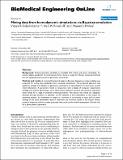Mining data from hemodynamic simulations via Bayesian emulation
Author(s)
Bressloff, Neil W; Kolachalama, Vijaya Bhasker; Nair, Prasanth B.
Download1475-925X-6-47.pdf (944.8Kb)
PUBLISHER_CC
Publisher with Creative Commons License
Creative Commons Attribution
Terms of use
Metadata
Show full item recordAbstract
Background: Arterial geometry variability is inevitable both within and across individuals. To ensure realistic prediction of cardiovascular flows, there is a need for efficient numerical methods that can systematically account for geometric uncertainty. Methods and results: A statistical framework based on Bayesian Gaussian process modeling was proposed for mining data generated from computer simulations. The proposed approach was applied to analyze the influence of geometric parameters on hemodynamics in the human carotid artery bifurcation. A parametric model in conjunction with a design of computer experiments strategy was used for generating a set of observational data that contains the maximum wall shear stress values for a range of probable arterial geometries. The dataset was mined via a Bayesian Gaussian process emulator to estimate: (a) the influence of key parameters on the output via sensitivity analysis, (b) uncertainty in output as a function of uncertainty in input, and (c) which settings of the input parameters result in maximum and minimum values of the output. Finally, potential diagnostic indicators were proposed that can be used to aid the assessment of stroke risk for a given patient's geometry.
Date issued
2007-12Department
Harvard University--MIT Division of Health Sciences and TechnologyJournal
BioMedical Engineering Online
Publisher
BioMed Central Ltd
Citation
BioMedical Engineering OnLine. 2007 Dec 13;6(1):47
Version: Final published version
ISSN
1475-925X